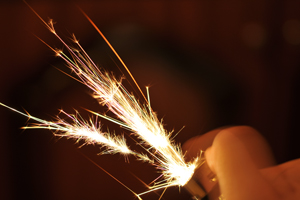Keep Your Eyes Safe This Independence Day

Allowing children to play with fireworks of any type, including sparklers, can be dangerous.
During the Fourth of July, fireworks are an American tradition. They are bright, beautiful, sparkly and fun—but they can injure you. According to the U.S. Consumer Product Safety Commission, more than 9,000 fireworks-related injuries occur each year.
Kelly Mitchell, M.D., Texas Tech Physicians Eye Clinic, said of these, nearly half are head-related injuries with nearly 30 percent of these injuries to the eyes.
“One-fourth of fireworks eye injuries result in permanent vision loss or blindness,” Mitchell said. “Children are the most common victims of firework accidents, with those 15 years old or younger accounting for half of all fireworks eye injuries in the U.S.”
Mitchell said many parents feel sparklers are innocent and cannot harm a child. But for children under the age 5, sparklers account for one-third of all fireworks injuries.
“Remember that sparklers can burn at almost 2,000 degrees Fahrenheit, which is as hot as a burning charcoal grill and hot enough to quickly cause a third-degree burn and a severe eye injury if not handled correctly,” Mitchell said.
For a safe and healthy Independence Day celebration, the American Academy of Ophthalmology gives the following fireworks safety tips:
- Always wear protective eye wear if you are using fireworks.
- Never let children play with fireworks of any type.
- View fireworks from a safe distance: at least 500 feet away, or up to a quarter of a mile for best viewing.
- Leave the lighting of fireworks to trained professionals.
- Follow directives given by event ushers or public safety personnel.
- If you find unexploded fireworks remains, do not touch them.
Mitchell said if you do injure your eye, do not put pressure on it or rub it. The best thing is to promptly get to a physician or hospital for care.
“Almost all eye injuries from fireworks are preventable,” Mitchell said. “Take precautions to keep your family safe to have a wonderful holiday.”
Related Stories
Celebrating Veterans: TTUHSC’s General Martin Clay’s Legacy of Service and Leadership
From his initial enlistment in the Army National Guard 36 years ago to his leadership in military and civilian health care management roles, Major General Martin Clay’s career has been shaped by adaptability, mission focus and service to others.
Texas Tech University Health Sciences Center School of Nursing Named Best Accelerated Bachelor of Science in Nursing Program in Texas
The TTUHSC School of Nursing Accelerated Bachelor of Science in Nursing (BSN) program has been ranked the No. 1 accelerated nursing program in Texas by RegisteredNursing.org.
TTUHSC Names New Regional Dean for the School of Nursing
Louise Rice, DNP, RN, has been named regional dean of the TTUHSC School of Nursing on the Amarillo campus.
Recent Stories
Making Mental Health a Priority in the New Year
Sarah Mallard Wakefield, M.D., a psychiatrist with Texas Tech Physicians, talks about strategies to combat widespread and growing anxiety.
TTUHSC Cancer Researcher Honored by National Academy of Inventors
C. Patrick Reynolds, M.D., Ph.D., director of the School of Medicine Pediatric Cancer Research Center at TTUHSC, has dedicated his life as a researcher to developing treatments for childhood cancers.
TTUHSC School of Nursing Celebrates 10 Years of the Veteran to BSN Program
The TTUHSC School of Nursing recognized the 10-year anniversary of the Veteran to Bachelor of Science in Nursing (VBSN) program during the fall 2025 commencement ceremonies held Dec. 13 in Lubbock, Texas.
